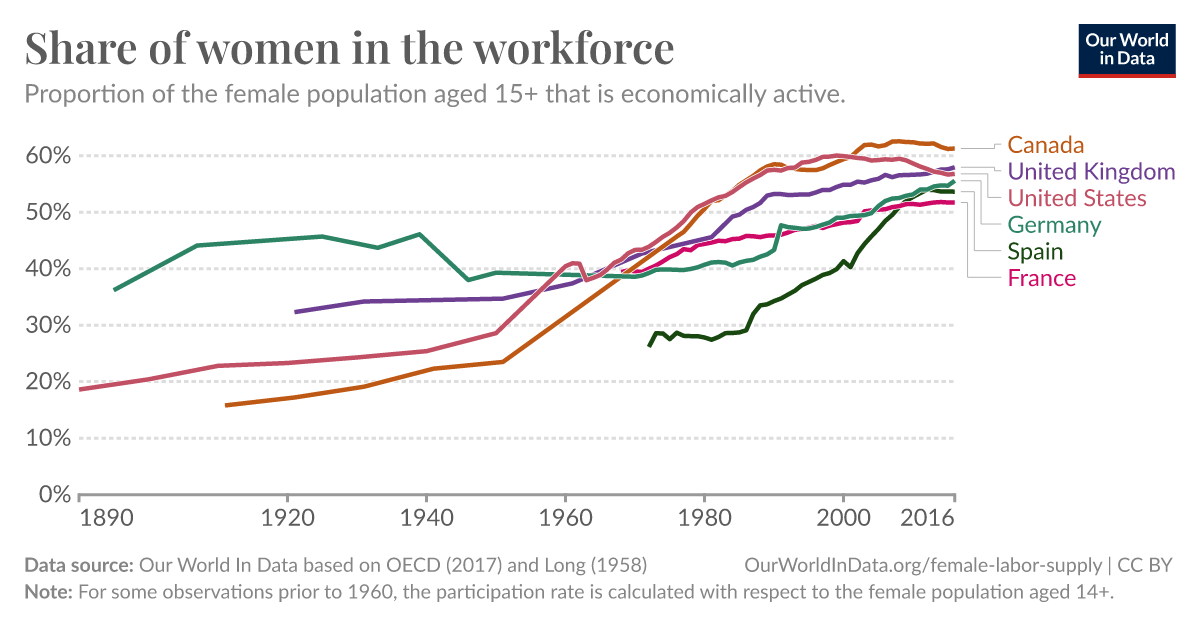Reading through this thread, I find it very U.S. centric. Not surprising with an American board where the majority of posters are American. What I do find a bit surprising is the almost unanimous view the anecdata shows.
I grew up in Sweden as middle class and from my American friends I know that the financial gap between the countries weren’t that wide in the 60’s. And yet, my mother went back to work when I was three months old. My grandma, who had just retired after working her whole life, took care of me. My other grandma also worked, with breaks for kids, all her life.
But since this is FQ, I decided to do a little digging. Not only for this thread, but it’s a widespread truism here as well that families could survive on one income. It’s my experience and most of my friends, on both side of the Atlantic, that our moms worked as much as they could, not for ‘pocket money.’ I’ll keep this to U.S. data.
While no one here has claimed that all American families could survive on one income in the 50’s, I do think it was less prevalent than many think:
By the 1930s, women had been slowly entering the workforce in greater numbers for decades. But the Great Depression drove women to find work with a renewed sense of urgency as thousands of men who were once family breadwinners lost their jobs. A 22 percent decline in marriage rates between 1929 and 1939 also meant more single women had to support themselves.
The rapid expansion of the government under the New Deal increased demand for secretarial roles that women rushed to fill and created other employment opportunities, albeit limited ones, for women.
Cite.
while 8 percent of employed women in 1890 were married, that figure rose to 26 percent in 1930 and 47 percent by 1950. These increases were the result of the rise of offices requiring clerical workers and new information technologies, along with tremendous growth in the number of women attending high school in the early 20th century.
Cite.
One more data point: In the U.S. the percentage of women in the chart below rose from 28.6 to 40.4 between 1950 and 1960.
Another thing to remember is that for many women being a SAHM wasn’t a choice.
The fact that many women left work upon marriage reflected cultural norms, the nature of the work available to them, and legal strictures. The occupational choices of those young women who did work were severely circumscribed.
Despite the widespread sentiment against women, particularly married women, working outside the home and with the limited opportunities available to them, women did enter the labor force in greater numbers over this period, with participation rates reaching nearly 50 percent for single women by 1930 and nearly 12 percent for married women.
Between the 1930s and mid-1970s, women’s participation in the economy continued to rise, with the gains primarily owing to an increase in work among married women. By 1970, 50 percent of single women and 40 percent of married women were participating in the labor force. Several factors contributed to this rise. First, with the advent of mass high school education, graduation rates rose substantially. At the same time, new technologies contributed to an increased demand for clerical workers, and these jobs were increasingly taken on by women. Moreover, because these jobs tended to be cleaner and safer, the stigma attached to work for a married woman diminished. And while there were still marriage bars that forced women out of the labor force, these formal barriers were gradually removed over the period following World War II.
Cite for the previous three paragraphs.
This might also shed some light


